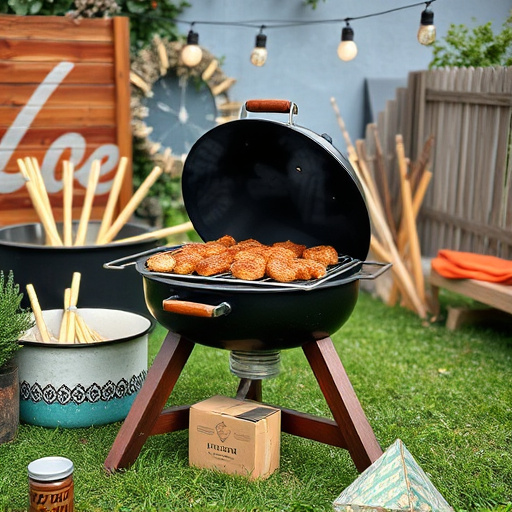Selecting the perfect cut of boneless, skinless chicken breasts (6-8 oz each) is essential for a delicious BBQ chicken breast dish. Keep an eye out for fresh, unbruised meat and consider organic or free-range options. Marinate your chicken in a sauce made with barbecue sauce, olive oil, garlic, and spices for 30 minutes to enhance flavor. Ensure even cooking and tender texture by trimming fat, seasoning generously, and marinating before grilling at 375°F (190°C). Create a mouthwatering BBQ sauce using ketchup, brown sugar, vinegar, Worcestershire sauce, salt, and spices, or opt for a sweet and savory mix with garlic powder and paprika. Use slow cooking techniques like indirect grill heat or a slow cooker to achieve tender, juicy results.
Discover the secrets to creating a mouthwatering BBQ chicken breast recipe with this comprehensive guide. From choosing the perfect cut of meat to crafting the ideal sweet barbecue sauce, we’ll walk you through every step for tender, flavorful results. Learn preparation techniques, cooking methods, and pairing ideas to elevate your BBQ game. Get ready to impress with this versatile dish, perfect for any occasion!
- Choosing the Right Chicken Breast
- – Types of chicken breasts and their suitability for BBQ sauce
- Preparation Techniques
- – Trimming, seasoning, and marinating tips for maximum flavor
- Creating a Delicious Sweet BBQ Sauce
- – Ingredients, proportions, and cooking methods for a balanced sweet and savory sauce
- Cooking Methods for Tender Results
Choosing the Right Chicken Breast
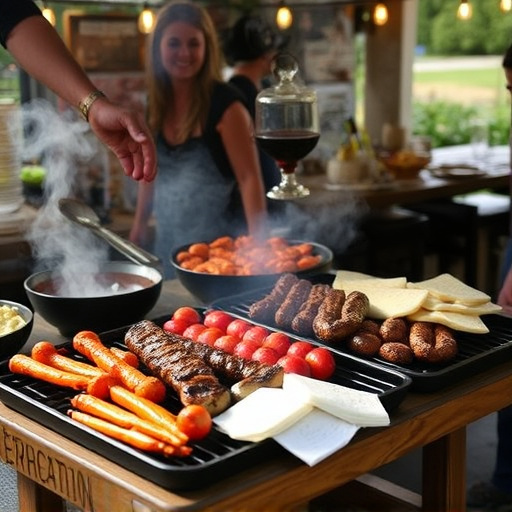
When crafting a mouthwatering BBQ chicken breast recipe, selecting the perfect cut of chicken is a crucial first step. Opt for boneless, skinless chicken breasts to ensure even cooking and a tender texture—this cut is ideal for soaking up the rich, sweet barbecue sauce. Look for breasts that are roughly 6-8 ounces each to balance flavor and portion size.
Freshness matters; choose chicken that’s displayed at a cold temperature in the refrigerated section. Check for any signs of bruising or deformity, and consider buying organic or free-range if availability permits. Properly stored, fresh chicken will keep for 1-2 days in the refrigerator, making it convenient to prepare your BBQ chicken breast recipe whenever the craving strikes.
– Types of chicken breasts and their suitability for BBQ sauce
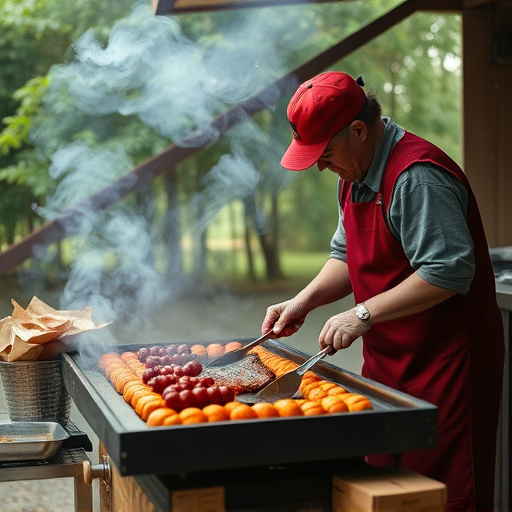
When it comes to BBQ chicken breast recipes, different cuts offer unique advantages. The most common type for barbecue is the boneless, skinless chicken breast. This cut is popular due to its versatility and relatively quick cooking time, making it ideal for grilling. Its smooth texture allows the sweet barbecue sauce to cling and caramelize beautifully, creating a mouthwatering blend of flavors.
For a truly delicious BBQ chicken breast experience, consider using organic or free-range breasts if possible. These options tend to have richer, more intense flavors that pair exceptionally well with the smoky sweetness of barbecue sauce. Their higher fat content also ensures the meat remains moist and tender during the cooking process.
Preparation Techniques
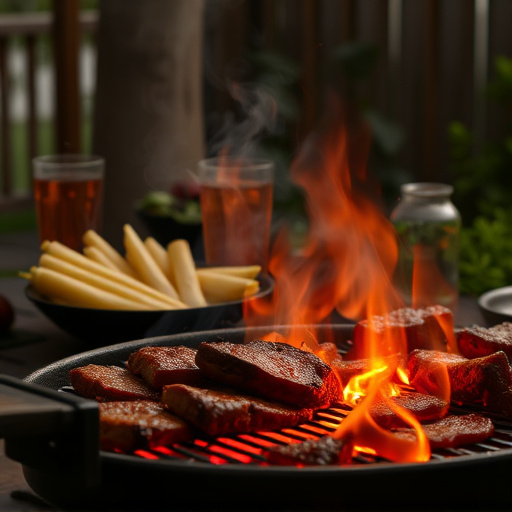
When preparing a mouthwatering BBQ chicken breast recipe, there are several techniques to enhance flavor and texture. Start by marinating your chicken breasts in a mixture of sweet barbecue sauce, olive oil, garlic, and your choice of spices for at least 30 minutes. This step allows the flavors to penetrate the meat, creating a luscious and aromatic dish. You can use a store-bought sauce or whip up your own, blending ketchup, vinegar, brown sugar, paprika, and a hint of cayenne pepper for a balanced sweet and smoky profile.
After marinating, grill your chicken on medium-high heat until it reaches an internal temperature of 165°F (74°C). This ensures the meat is cooked through while keeping it juicy. For added depth, brush on more sauce during the last few minutes of cooking to create a glistening, caramelized exterior. Let the chicken rest for a couple of minutes before slicing to allow the juices to redistribute, resulting in tender and flavorful BBQ chicken breast slices every time.
– Trimming, seasoning, and marinating tips for maximum flavor

To achieve mouthwatering results with your BBQ chicken breast recipe, pay close attention to three key steps: trimming, seasoning, and marinating. Begin by trimming any excess fat from the chicken breasts to ensure even cooking and prevent grease buildup. This simple step enhances flavor by allowing the sweet barbecue sauce to shine. Next, season both sides generously with salt, pepper, and your choice of spices—smoked paprika, garlic powder, or cayenne pepper are excellent options for adding depth and heat.
Marinating is a game-changer for BBQ chicken breast recipes. Allow the meat to soak in a mixture of oil, vinegar, soy sauce, brown sugar, and your favorite BBQ sauce for at least 30 minutes before cooking. This process tenderizes the chicken, infuses it with rich flavors, and ensures that your BBQ sauce adheres perfectly when brushed on during grilling.
Creating a Delicious Sweet BBQ Sauce

Creating a delicious sweet BBQ sauce is key to transforming your simple bbq chicken breast recipe into something extraordinary. Start by combining your favorite barbecue sauce base, typically tomato ketchup, brown sugar, and apple cider vinegar. Heat the mixture in a saucepan over medium heat, stirring occasionally until the sugar dissolves completely. Once bubbly, add a touch of Worcestershire sauce and a pinch of salt for depth of flavor. Continue to simmer, allowing the sauce to thicken slightly, about 5-7 minutes. This balance of sweet, tangy, and savory notes is what makes it perfect for coating tender chicken breasts.
For an extra kick, add a splash of your favorite hot sauce or chili flakes just before serving. The contrast between the sweet barbecue sauce and the savory, juicy chicken creates a flavor profile that’s hard to resist, making this bbq chicken breast recipe a crowd-pleaser at any gathering.
– Ingredients, proportions, and cooking methods for a balanced sweet and savory sauce

To craft a balanced sweet and savory barbecue sauce for your BBQ chicken breast recipe, start with a base of ketchup, brown sugar, and apple cider vinegar. These ingredients form a classic combination that lends both depth and tanginess to the sauce. Use 1/2 cup each of ketchup and brown sugar, and 1/4 cup of vinegar as a starting point, adjusting proportions to your taste preference.
Next, incorporate garlic powder, onion powder, salt, and pepper for savory notes. A splash of Worcestershire sauce and a sprinkle of smoked paprika can add complexity and an authentic barbecue flavor. Simmer the mixture over medium heat until thickened slightly, stirring occasionally to prevent burning. This blend of ingredients ensures your chicken breast soaks up not only the sweet flavors but also the savory richness, creating a mouthwatering BBQ chicken breast recipe that’s sure to satisfy.
Cooking Methods for Tender Results
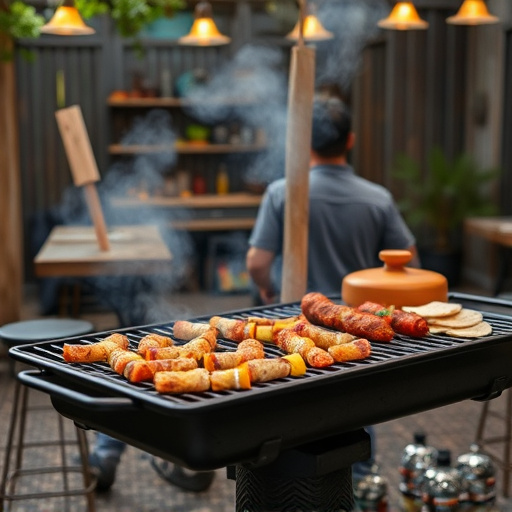
When it comes to achieving tender and juicy results in your BBQ chicken breast recipe, the cooking method plays a pivotal role. One effective technique is slow cooking, which allows the heat to gently permeate the meat, breaking down tough collagen fibers and resulting in a melt-in-your-mouth texture. You can achieve this by grilling over low indirect heat or using a slow cooker for a more hands-off approach.
Another method that ensures tender chicken breast is searing followed by braising. Start by rapidly searing the breasts on high heat to create a delicious crust, locking in flavors. Then, reduce the temperature and continue cooking in a sauce or broth until the meat becomes tender. This combination of high heat and moist cooking environments helps to keep the chicken moist and flavorful throughout the process.
